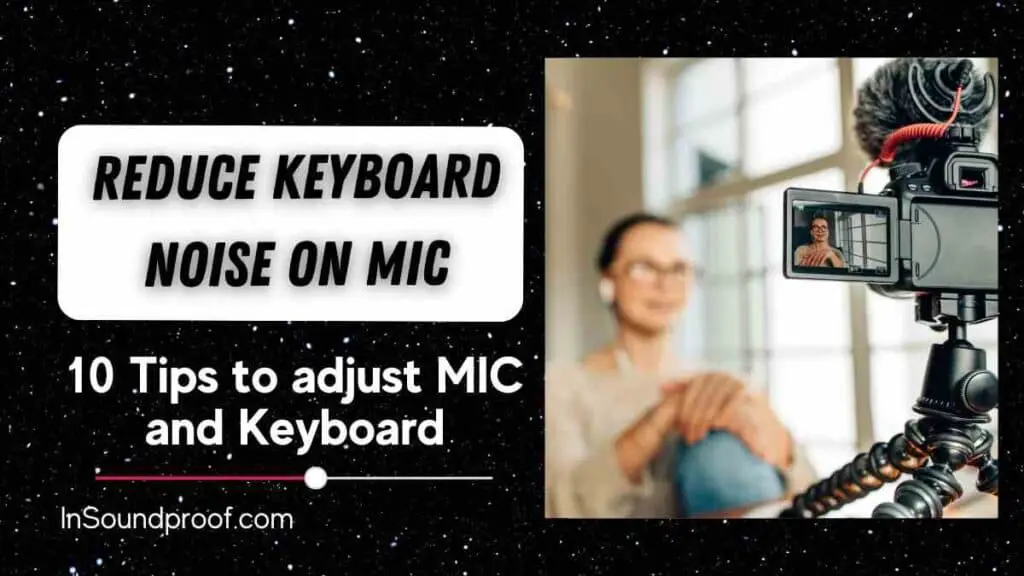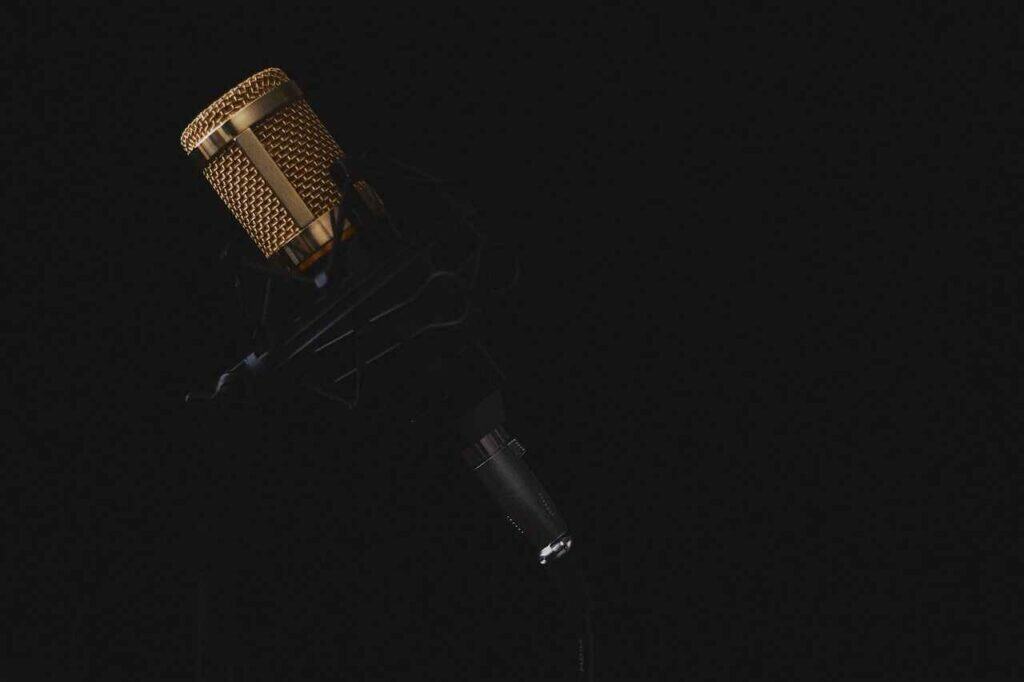Are you a streamer or filmmaker looking for ways to reduce keyboard noise on mic? You’re not alone.
Noise from the Keyboard can ruin your audio recordings and distract viewers and listeners.
Because of the mechanical movement of the keys and the underlying switches, keyboards create noise when you type. The switch beneath a key is triggered when pressed, and the sound made when it strikes the keyboard’s base, or the button itself depends on the key’s direction.
Fortunately, minimizing these sounds is possible with a few simple steps.
In this article, we’ll explore ten tips on how to reduce keyboard noise on mic for improved sound quality and a more pleasant experience for everyone involved. Let’s get started.
Soundproofing: Best 15 Ideas to Soundproof a Garage DIY

Table of Contents
Noise Making Keyboards
The mechanical keyboard is typically the one that produces the most noise. Individual mechanical switches are used by each key on mechanical keyboards, which create both tactile and audible feedback when pressed.
The switch mechanism, which frequently uses a metal spring or other component that emits a loud “click” or “clack” sound, causes the noise.
Membrane keyboards, frequently seen in budget keyboards and computers, make less noise in contrast. These keyboards place a layer of rubber or silicone beneath the keys to give a subtle, soft touch.
Since no movement is involved, they are quieter than mechanical keyboards, and a membrane layer registers keystrokes.
The switch mechanism used in the keyboard design is what causes the noise.
Although mechanical keyboards often produce more noise than membrane keyboards, many users prefer them because they offer a distinctive and gratifying typing experience.
Soundproofing: Soundproof Interior Door DIY Methods
How to Reduce Keyboard Noise on Mic (10 Options)
#1 Use a Noise-Cancelling MIC
Noise-canceling mics are specifically designed to reduce unwanted background noise and improve the quality of recordings by canceling out ambient sound.
In this way, you won’t have to worry about any sound leakage from your keyboard into your video or stream.
Having one of these mics attached to your recorder or computer while you record will help reduce keyboard noise on the mic.
Noise-canceling mics use two transducers—an electrically modified version of the microphone, which is used to pick up sound, and a secondary reverse-polarity transducer that reproduces the sound in antiphase with the first.
By producing these two signals out of phase, they cancel out unwanted background noise and reduce it by up to 20 dB. The result is an improved signal-to-noise ratio that helps eliminate any keyboard noise on mic.
#2 Change Your Typing Techniques

If you type too hard, the sound from your Keyboard can become too loud.
To fix this, try using a low-touch typing technique where you hit the keys with just enough pressure for them to make contact and no more.
Additionally, consider investing in switches or dampers that absorb some of the sound generated by your Keyboard.
Also, if you frequently move your hands while typing, move them slower to reduce the noise produced.
You can also practice good posture while typing and keep your elbows close to your body to minimize movement and noise levels.
#3 Install Noise Suppression Software
Many noise suppression software programs are available that can help reduce background noise while you type.
These programs sense the environment and reduce noise interference with a unique algorithm created to help filter and clean up the sound.
The software is adjustable, so you can customize the setting and find a balance between reducing distractions and still allowing important sounds through.
While such software is not 100% perfect, it can go a long way toward making typing more enjoyable in busy environments. Krisp or RTX Voice are two popular noise suppression software options.
Krisp noise suppression software uses artificial intelligence-based algorithms to identify and eliminate unwanted background noise from audio sources.
This process is done in real-time, meaning any sound coming from outside the recording or being picked up by the microphone is blocked before it can create unwanted sound interference.
The process is designed to be unobtrusive, meaning no changes are heard in the sound quality of the source material.
RTX Voice works slightly differently, using AI algorithms to detect and filter specific sounds from audio sources.
It offers custom profiles for filtering out different types of background noise and a simple user interface that makes setup easy.
Once setup is complete, RTX Voice will detect and filter out noises such as freeway traffic, wind, or construction work while allowing voices.
#4 Use a directional microphone

If you record or stream from your desk, a directional microphone will help reduce background noise while amplifying your voice.
These microphones are designed to pick up sound only from their facing direction, thereby reducing distractions and outside noise.
Audio-Technica AT2020USB+ is a good starter option for a USB condenser microphone with an adjustable recording pattern. You can also look for recordings made with this microphone and see if you like the sound.
A directional microphone, such as the Audio-Technica AT2020USB+, works by selectively picking up sounds within its field of view while allowing ambient noise outside that field of view to be reduced or eliminated.
This is achieved using a cardioid or hyper-cardioid pattern, which utilizes a diaphragm with two capsules that combine and cancel out sound from the sides and rear. It also has adjustable gain knobs that you can use to control sensitivity and help optimize the sound for different recording situations.
This combination of features makes this microphone ideal for reducing unwanted background noise while providing clear, natural audio.
#5 Use a Keyboard Mat
Using a keyboard mat is one of the best ways to reduce keyboard noise on a mic, as it muffles the sound of typing and provides some cushioning for your wrists.
This helps reduce the amount of sound picked up by the mic. Choose a thick, anti-slip mat for optimal performance.
A keyboard mat is a specially designed to reduce noise from keyboards. It’s usually made of thicker foam or rubber material and is placed on the desk or floor beneath your Keyboard.
The mat works by muffling the sound of typing while providing cushioning for your wrists, which helps keep you comfortable while typing.
Additionally, the thicker material helps to absorb sound waves before they reach the microphone, reducing their overall volume. This allows for clearer audio recording without any background noise from the Keyboard itself
#6 Insulate Your Keyboard
If your Keyboard is causing too much noise, insulate it.
Place a small piece of foam underneath your keys as a buffer to do so. This will absorb some of the sound coming from your Keyboard and make for better recordings.
You are insulating your Keyboard with a piece of foam that works by absorbing sound before it is sent into the room. The foam works by dampening the vibrations caused by typing and thus reduce the noise created when you type.
It also helps to minimize outside interference from other noises in the room, making for more crystal-clear recordings. Additionally, the foam has a more comfortable feel than hard surfaces, making it easier to type on and reducing fatigue over time.
#7 Use a Noise Gate Effect
A noise gate adapts the speed of volume changes to either remove or decrease unwanted noises.
In this case, you can use it to reduce the sound of your Keyboard if it’s too loud for your recording.
Before recording, you can easily add noise gates to your audio software’s effects tab.
An example is an audio plugin such as the free VST plugin “Noise Gate.” you can use this plugin to analyze a signal and determine when the level of sound coming from the Keyboard is too loud. When this happens, it will reduce or eliminate the sound. The threshold, hold, and release times can be adjusted to fit whatever source you are working with.
#8 Move Your Mic Away from the Keyboard
Positioning the microphone away from your Keyboard will help prevent it from picking up any unwanted noise and provide better sound quality overall.
Try moving the mic a few feet away – this should make a big difference!
One way to move your mic away from the Keyboard is to use a boom mount. A boom mount sits on top of a microphone stand and allows you to move the microphone closer or farther away from your source.
It also can swivel around for increased flexibility when aiming for that perfect sound.
The Gator GM-1 B is popular as it features telescoping arms to easily adjust the height and an adjustable angle clamp to allow directional sound capture from various angles. This makes it ideal for recording keyboards without picking up too much-unwanted noise.
#9 Utilize Low Noise Keyboards
Mechanical keyboards are designed in such a way that they emit less noise compared to regular keyboards and are thus much better suited for recordings and streams alike.
Opting for one of these low-noise models is highly recommended to significantly reduce keyboard noise on mic.
Be sure to check reviews before making your purchase!
Mechanical keyboards use mechanical switches under the keys with a spring-back bottom-out system that helps keep noise to a minimum.
Unlike membrane keyboards which transmit noise through their rubber membranes, mechanical keyboards are much quieter and feel more comfortable since they don’t need as much force to press down.
Some models even have integrated dampening technology, where an o-ring between the switch and its housing absorbs any sound that may have escaped. This helps reduce the overall sound coming from your Keyboard while typing.
#10 Wear Headphones
Wearing headphones to reduce keyboard noise creates a barrier between you and the sound from the Keyboard. This is because the headphones will absorb most of the sound and direct it away from your ears.
The ear cups’ shape and cushioning materials surrounding them form a seal, blocking out external sounds and allowing only your desired audio to come through.
Earphones will produce some sound leakage at higher volumes, but this is typically minimal and won’t be disruptive to those around you.
Headphones also work by taking advantage of the isolation effect. This phenomenon is created by the small gap between the ear cups and your head, which results in ambient noise being cut off, allowing you to hear only what is coming through your headphones. This can reduce external noise dramatically, especially in noisy environments.
Using headphones when recording or streaming with keyboards helps to reduce noise and improve sound quality by creating an acoustic seal between your ears and the environment. The headphones act as a barrier, blocking out potential external noises and allowing you to concentrate on the sound of your Keyboard while recording or streaming.
Headphones also create a sense of ‘isolation,’ meaning you can hear the nuances in your music production more accurately. Additionally, acoustic foam inside the headphones helps attenuate sound frequencies, which can cause additional noise in recordings or streams. This foam reduces high-frequency signals that could potentially interfere with your audio recordings after it’s been captured by your microphone
Some Extra Factors To Consider
Installing soundproofing material in a room can help reduce or eliminate noise, such as keyboard sound. This is accomplished by using acoustic foam, fiberglass insulation, and other materials that absorb sound waves.
Acoustic foam is composed of a porous material that creates tiny air pockets, which absorb incoming sound waves and dissipate their energy.
Fiberglass insulation helps reduce sound transmission through walls by blocking the noise from entering a room. These materials can be glued or nailed to walls, ceilings, and other surfaces to create effective soundproofing.
Additionally, it would be best to seal doors and windows with weather stripping to prevent sound from escaping the room.
Installing soundproofing material in a room will help reduce or eliminate noise levels and create a comfortable, quiet environment
Conclusion
Reducing keyboard noise on your microphone is essential if you want to produce clear audio recordings.
By following the tips outlined above, you can minimize the sound of your Keyboard while still enjoying the tactile feel of typing.
Insulating your Keyboard with a piece of foam is an effective way to do this, as it absorbs sound and reduces outside interference from other noises in the room.
Additionally, using a pop filter and ensuring your microphone isn’t too close to the Keyboard will help reduce unwanted noise.
Taking these steps will ensure that you have high-quality audio recordings with no background noise from your Keyboard.
10 FAQs to Reduce Keyboard Noise on Mic
Q 1: How do I make my mic pick up less keyboard noise?
Ans: To reduce the amount of keyboard noise picked up by your microphone, you can use a pop filter or sound-dampening material to absorb some of the sounds before it reaches the mic. You can also insulate your Keyboard with foam to dampen the vibrations caused by typing, making for clearer recordings.
Q 2: How do I make my mic not pick up mouse clicks?
Ans: To reduce the number of mouse clicks picked up by your microphone, you can use a pop filter or sound-dampening material to absorb some of the sounds before it reaches the mic. You can also adjust your microphone’s settings to reduce sensitivity and reduce the amount of noise it picks up. Finally, you can ensure that accessories like mouse pads are placed away from your microphone to reduce interference.
Q 3: How do I stop my mic from picking up keyboard discord?
Ans: To reduce the amount of keyboard discord picked up by your microphone, you can use a pop filter or sound-dampening material to absorb some of the sounds before it reaches the mic. You can also adjust your microphone’s settings to reduce sensitivity and reduce the amount of noise it picks up. Finally, you can use a soft keyboard pad to muffle the sound of typing and reduce discord.
Q 4: Why does my Keyboard make so much noise when I type?
Ans: Your Keyboard may be making a lot of noise when you type due to several factors, such as the type of material it is made from, how worn out the keys are, and how hard you are pressing them. You can use a softer keyboard pad to muffle the sound or adjust your typing speed and force to reduce the noise. You can also look into replacing your Keyboard with a quieter model.
Q 5: What is the best Keyboard sound dampening material?
Ans: The best sound-dampening material for keyboards depends on your needs and budget. Some popular options include neoprene rubber, acoustic foam, and cork. You can also use thick rugs or blankets to muffle the sound of typing.
Q 6: Why does my mic pick up computer sounds?
Ans: Your mic may be picking up computer sounds due to its sensitivity settings or the microphone’s proximity to the computer. You can adjust your microphone’s sensitivity settings or move it away from the computer to reduce this noise. Additionally, you can use a sound-dampening material such as acoustic foam or cork to absorb any sound waves that reach the mic.
Q 7: Is there such a thing as a quiet mechanical keyboard?
Ans: Yes, there are quite mechanical keyboards available on the market. These keyboards use quieter switches and dampening materials such as o-rings to reduce the sound of typing. Additionally, some models feature a sound-dampening frame to reduce noise output further.
Q 8: Which mechanical key is silent?
Ans: The Cherry MX Silent Red mechanical switch is one of the quietest mechanical switches available. It uses a unique dampening material to reduce the sound of typing and has a linear actuation point for smooth and responsive typing.
Q 9: How do I stop my mic from picking up background noise?
Ans: To reduce background noise from your microphone, you can adjust the sensitivity settings or move it away from the noise source. Additionally, you can use a sound-dampening material such as acoustic foam or cork to absorb any sound waves that reach the mic. You can also use a pop filter to reduce plosives and other harsh sounds.
Q 10: How do I reduce the keyboard noise on my mic Streamlabs?
Ans: Using an external audio interface, you can reduce the keyboard noise on your Streamlabs mic. This will allow you to adjust the gain and EQ settings to reduce the sound of typing. You can also use a pop filter to reduce plosives and other harsh sounds.

